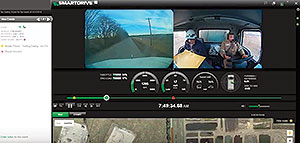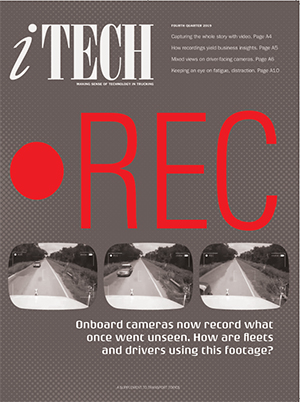Analysis of Onboard Video Can Yield Operational Insights

The video and data captured by onboard cameras are enabling fleets to identify operational goals and measure progress.
“Cameras are no longer just cameras,” said Jai Ranganathan, vice president of products at KeepTruckin, a provider of electronic logging devices and dash cams. “It is about the interesting things you can do to get insights from what the cameras are capturing.”
As onboard video systems become more advanced, fleets are getting more targeted information, said Del Lisk, vice president of safety services for Lytx.

Vendors are building programs to help fleets extract insights from video-based data. (SmartDrive Systems via YouTube)
“That enables them to look beyond who are the highest and lowest risk drivers to evaluate the routes and times of day incidents are occurring,” he said. “The ways our data is being used is evolving to help fleets improve safety as well as productivity.”
Brian McCoy, vice president at MiX Telematics, said the company’s MiX Vision product integrates with its MiX Fleet Manager platform, which incorporates multiple types of analytics.
“Video clips become part of a driver’s scorecard, and our fleets are able to analyze trends at the driver, team and company level,” he said.
Fleets have analyzed data to discover that certain roads or routes are consistently problematic from a safety standpoint, with an unusual number of incidents or crashes, McCoy said. “Using that data, they can change routes and/or train drivers on how to handle that specific area,” he said.

Fourth Quarter iTECH
- A Witness in the Cab
- Some Fleets Reluctant to Add Driver-Facing Cameras
- Analysis of Onboard Video Can Yield Operational Insights
- Self-Driving Trucks and Presidential Politics
- Driver Training, Monitoring Could Help Ensure Safe Testing, Deployment of Automated Trucks
- In-Cab Monitoring Uses Machine Vision to Detect Fatigued, Distracted Driving
With a traditional dash cam setup, fleet managers are forced to sift through hours of video to find actionable insights, said Mathew Long of Verizon Connect.
“In contrast, smart dash cams intelligently capture and automatically classify video according to how severe an event is, showing only what is relevant and important to business operations managers,” he said.
Machine learning helps to improve the accuracy of the automated classification of event severity, Long said. “Smart video technology lets fleet managers know how severe an event was, whether it was a near miss or an actual collision, enabling corrective action without parsing hours of video.”
Trimble can track drivers’ behaviors behind the wheel and weights them according to the risk each behavior carries.
“We provide a red, yellow and green scoring on a single web page to show the risk. The 10 riskiest are red, the next are yellow, and the rest are green,” said Jim Angel, Trimble’s vice president of video intelligence solutions. “If you don’t make data actionable, the carrier won’t be successful.”
SmartDrive CEO Steve Mitgang said people understand there is value to be had from the data being gathered, but there are challenges. “They may not have access to data, or data is too sparse,” he said, adding that SmartDrive’s analysis can help fleets understand the business impact of their decisions. “You have to clearly articulate what you’re trying to do.”
If a fleet wants to reduce driver attrition to 73% from 85%, SmartDrive can dig into data to create a program.
“Once we get a few fleets doing it, we try to replicate it with automation,” Mitgang said. “I think what we’re seeing is fleets asking more questions — what else can we do, how can we do it, and how can you help us?”
SmartDrive also works with customers to find ways to make data more useful.
“Customers are articulating problems that the data should be able to understand,” Mitgang said.
Five years ago, SmartDrive asked a fleet for its riskiest behavior on the highway that may not have operational visibility.
As a result, SmartDrive created triggers to identify a U-turn on a highway.
“We said, how do we know a U-turn is happening on an open highway versus a distribution center? One is safe. One isn’t safe,” Mitgang said.
Adding tags to recorded events helps fleets identify the most important events first, said Eleanor Horowitz, team lead for product marketing at Samsara.
“Samsara is collecting 100 billion data points a year. Reviewing that much is unwieldy and unmanageable,” she said, adding that technology can identify the ones that matter. “We can say, ‘Of your 100 events, here are the 10 events you should review first.’ ”
The information attached to a video clip enables meaningful notifications and substantial driver coaching by creating contextual awareness, said Adam Kahn, president of Netradyne’s fleet business.
“You can identify what you need to look at right now,” he said. “If I have two drivers with 20 stop sign violations, and one is 30% compliant, and one is 99% compliant, I probably want to talk to that first driver.”

